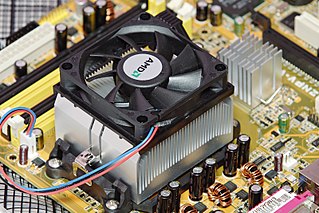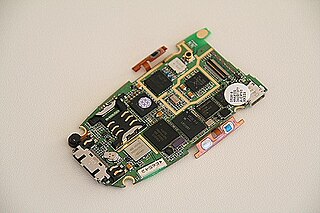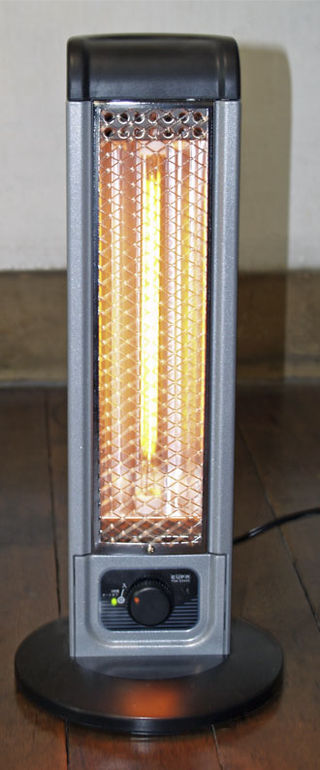Types of reflow ovens
Infrared and convection ovens
In infrared reflow ovens, the heat source is normally ceramic infrared heaters above and below the conveyor, which transfer heat to the PCBs by means of radiation.
Convection ovens heat air in chambers, using that air to transfer heat to the PCBs by means of convection and conduction. They may be fan assisted to control the airflow within the oven. This indirect heating using air allows more accurate temperature control than directly heating PCBs by infrared radiation, as PCBs and components vary in infrared absorptance.
Ovens may use a combination of infrared radiative heating and convection heating, and would then be known as 'infrared convection' ovens.
Some ovens are designed to reflow PCBs in an oxygen-free atmosphere. Nitrogen (N2) is a common gas used for this purpose. This minimizes oxidation of the surfaces to be soldered. The nitrogen reflow oven takes a few minutes to reduce Oxygen concentration to acceptable levels within the chamber. Thus nitrogen ovens typically have nitrogen injection in at all times which decreases defect rates. [1]
Vapour phase oven
The heating of the PCBs is sourced by thermal energy emitted by the phase transition of a heat transfer liquid (e. g. PFPE) condensing on the PCBs. The liquid used is chosen with a desired boiling point in mind to suit the solder alloy to be reflowed.
Some advantages of vapour phase soldering are:
- High energy efficiency due to the high heat transfer coefficient of vapour phase media
- Soldering is oxygen-free. There is no need for any protective gas (e.g. nitrogen)
- No overheating of assemblies. The maximum temperature assemblies can reach is limited by the boiling point of the medium.
This is also known as condensation soldering.
Pressure Curing Ovens
Pressure curing ovens, or Autoclave, is widely utilized to minimize voiding and improve adhesion strength in bonding processes. Pressure cure ovens are typically employed in die attach and underfill applications. Increasing pressure during the curing process removes voids.
In a pressure cure process, air is pressurized in a rigid vessel or chamber while heating or cooling with forced convection. Heaters, heat exchangers, and blowers are mounted internal to the pressure vessel, continuously circulating air across the pressure chamber providing consistent heat transfer to the product. Upon completion of the curing process, pressure is relieved and the product cools.
Pressure cure ovens can utilize air or nitrogen as the pressurizing agent.
Vacuum Reflow Ovens
Traditional reflow can be augmented by the addition of a late-stage vacuum chamber. Introducing a vacuum chamber to the reflow process allows voids and bubbles to escape, significantly reducing voiding in solder joints and interfaces.
During the vacuum process, the circuit board is stationary, assuring no shifting parts. Smooth travel into and out of the vacuum chamber, minimizing vibration, is critical.
Employing heat inside the vacuum chamber allows peak temperatures to be achieved during vacuum, assuring shorter time above liquidous and greater process flexibility. High vacuum chamber temperatures also prevent flux buildup inside the chamber.
Advanced vacuum reflow ovens employ multiple conveyor systems allowing higher throughput by optimizing transfer time into the vacuum chamber, dual rail processing, and closed-loop vacuum pumps to prevent solder and flux spatter.
Formic acid reflow ovens operate similarly to a traditionally reflow oven, with the addition of formic acid vapor injection into the key soak zones for flux-free reflow and vapor soldering. Upon injection, the formic acid removes any oxides present on the metal prior to reflow.
Formic acid concentration is maintained by a bubbler system that is monitored in real time to provide stable and consistent formic concentrations to within 0.5% in the process chamber.
Formic acid reflow ovens employ sets of double doors at the oven’s entrance and exit to dramatically reduce process gas consumption. During production, only one door opens at a time, thus isolating the process chamber and lowering nitrogen and formic acid consumption.

Heat transfer is a discipline of thermal engineering that concerns the generation, use, conversion, and exchange of thermal energy (heat) between physical systems. Heat transfer is classified into various mechanisms, such as thermal conduction, thermal convection, thermal radiation, and transfer of energy by phase changes. Engineers also consider the transfer of mass of differing chemical species, either cold or hot, to achieve heat transfer. While these mechanisms have distinct characteristics, they often occur simultaneously in the same system.

A ball grid array (BGA) is a type of surface-mount packaging used for integrated circuits. BGA packages are used to permanently mount devices such as microprocessors. A BGA can provide more interconnection pins than can be put on a dual in-line or flat package. The whole bottom surface of the device can be used, instead of just the perimeter. The traces connecting the package's leads to the wires or balls which connect the die to package are also on average shorter than with a perimeter-only type, leading to better performance at high speeds.

Surface-mount technology (SMT), originally called planar mounting, is a method in which the electrical components are mounted directly onto the surface of a printed circuit board (PCB). An electrical component mounted in this manner is referred to as a surface-mount device (SMD). In industry, this approach has largely replaced through-hole technology construction method of fitting components, in large part because SMT allows for increased manufacturing automation which reduces cost and improves quality. It also allows for more components to fit on a given area of substrate. Both technologies can be used on the same board, with the through-hole technology often used for components not suitable for surface mounting such as large transformers and heat-sinked power semiconductors.

Brazing is a metal-joining process in which two or more metal items are joined by melting and flowing a filler metal into the joint, with the filler metal having a lower melting point than the adjoining metal.

A heat sink is a passive heat exchanger that transfers the heat generated by an electronic or a mechanical device to a fluid medium, often air or a liquid coolant, where it is dissipated away from the device, thereby allowing regulation of the device's temperature. In computers, heat sinks are used to cool CPUs, GPUs, and some chipsets and RAM modules. Heat sinks are used with other high-power semiconductor devices such as power transistors and optoelectronics such as lasers and light-emitting diodes (LEDs), where the heat dissipation ability of the component itself is insufficient to moderate its temperature.

In metallurgy, a flux is a chemical reducing agent, flowing agent, or purifying agent. Fluxes may have more than one function at a time. They are used in both extractive metallurgy and metal joining.

A convection oven is an oven that has fans to circulate air around food to create an evenly heated environment. In an oven without a fan, natural convection circulates hot air unevenly, so that it will be cooler at the bottom and hotter at the top than in the middle. Fan ovens cook food faster, and are also used in non-food, industrial applications. Small countertop convection ovens for household use are often marketed as air fryers.

Wave soldering is a bulk soldering process used in printed circuit board manufacturing. The circuit board is passed over a pan of molten solder in which a pump produces an upwelling of solder that looks like a standing wave. As the circuit board makes contact with this wave, the components become soldered to the board. Wave soldering is used for both through-hole printed circuit assemblies, and surface mount. In the latter case, the components are glued onto the surface of a printed circuit board (PCB) by placement equipment, before being run through the molten solder wave. Wave soldering is mainly used in soldering of through hole components.
Ultra-high vacuum is the vacuum regime characterised by pressures lower than about 1×10−6 pascals. UHV conditions are created by pumping the gas out of a UHV chamber. At these low pressures the mean free path of a gas molecule is greater than approximately 40 km, so the gas is in free molecular flow, and gas molecules will collide with the chamber walls many times before colliding with each other. Almost all molecular interactions therefore take place on various surfaces in the chamber.

Reflow soldering is a process in which a solder paste is used to temporarily attach anywhere from one to thousands of tiny electrical components to their contact pads, after which the entire assembly is subjected to controlled heat. The solder paste reflows in a molten state, creating permanent solder joints. Heating may be accomplished by passing the assembly through a reflow oven, under an infrared lamp, or by soldering individual joints with a hot air pencil.

In electronics, rework is repair or refinish of a printed circuit board (PCB) assembly, usually involving desoldering and re-soldering of surface-mounted electronic components (SMD). Mass processing techniques are not applicable to single device repair or replacement, and specialized manual techniques by expert personnel using appropriate equipment are required to replace defective components; area array packages such as ball grid array (BGA) devices particularly require expertise and appropriate tools. A hot air gun or hot air station is used to heat devices and melt solder, and specialised tools are used to pick up and position often tiny components. A rework station is a place to do this work—the tools and supplies for this work, typically on a workbench. Other kinds of rework require other tools.

Selective soldering is the process of selectively soldering components to printed circuit boards and molded modules that could be damaged by the heat of a reflow oven or wave soldering in a traditional surface-mount technology (SMT) or through-hole technology assembly processes. This usually follows an SMT oven reflow process; parts to be selectively soldered are usually surrounded by parts that have been previously soldered in a surface-mount reflow process, and the selective-solder process must be sufficiently precise to avoid damaging them.

Flat no-leads packages such as quad-flat no-leads (QFN) and dual-flat no-leads (DFN) physically and electrically connect integrated circuits to printed circuit boards. Flat no-leads, also known as micro leadframe (MLF) and SON, is a surface-mount technology, one of several package technologies that connect ICs to the surfaces of PCBs without through-holes. Flat no-lead is a near chip scale plastic encapsulated package made with a planar copper lead frame substrate. Perimeter lands on the package bottom provide electrical connections to the PCB. Flat no-lead packages usually, but not always, include an exposed thermally conductive pad to improve heat transfer out of the IC. Heat transfer can be further facilitated by metal vias in the thermal pad. The QFN package is similar to the quad-flat package (QFP), and a ball grid array (BGA).

An infrared heater or heat lamp is a heating appliance containing a high-temperature emitter that transfers energy to a cooler object through electromagnetic radiation. Depending on the temperature of the emitter, the wavelength of the peak of the infrared radiation ranges from 750 nm to 1 mm. No contact or medium between the emitter and cool object is needed for the energy transfer. Infrared heaters can be operated in vacuum or atmosphere.

Industrial ovens are heated chambers used for a variety of industrial applications, including drying, curing, or baking components, parts or final products. Industrial ovens can be used for large or small volume applications, in batches or continuously with a conveyor line, and a variety of temperature ranges, sizes and configurations.

A thermal profile is a complex set of time-temperature data typically associated with the measurement of thermal temperatures in an oven. The thermal profile is often measured along a variety of dimensions such as slope, soak, time above liquidus (TAL), and peak.

Soldering is a process of joining two metal surfaces together using a filler metal called solder. The soldering process involves heating the surfaces to be joined and melting the solder, which is then allowed to cool and solidify, creating a strong and durable joint.
Out of autoclave composite manufacturing is an alternative to the traditional high pressure autoclave (industrial) curing process commonly used by the aerospace manufacturers for manufacturing composite material. Out of autoclave (OOA) is a process that achieves the same quality as an autoclave but through a different process. OOA curing achieves the desired fiber content and elimination of voids by placing the layup within a closed mold and applying vacuum, pressure, and heat by means other than an autoclave. A resin transfer molding (RTM) press is the typical method of applying heat and pressure to the closed mold. There are several out of autoclave technologies in current use including RTM, same qualified resin transfer molding (SQRTM), vacuum-assisted resin transfer molding (VARTM), and balanced pressure fluid molding. The most advanced of these processes can produce high-tech net shape aircraft components.

Graping is a phenomenon marked by the appearance of unreflowed solder particles on top of the solder mass. The solder that is partially coalesced resembles a cluster of grapes, hence the derivation of the phenomenon’s name.

A conveyor belt furnace is a furnace that uses a conveyor or belt to carry process parts or material through a primary heating chamber for rapid thermal processing. It is designed for fast drying and curing of products, and has widespread use in the firing process of thick film and metallization process of solar cell manufacturing. Other names for conveyor belt furnace include metallization furnace, belt furnace, atmosphere furnace, infrared furnace and fast fire furnace.



















